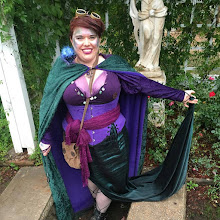Book Info:
The Earth, My Butt, and Other Big Round Things by Carolyn Mackler. Candlewick Press, 2003.
Summary:
Virginia Shreves does not fit in with her family. She constantly feels that she was switched at birth with someone else, given that her family are mostly thin and perfect while she's slightly plus-sized and awkward. However, her problems are compounded when her older brother, Byron, is suspended from college after being charged with date raping a girl. Soon Virginia begins to rebel in bigger ways than just sneaking Froggy Welsh the Fourth into her bedroom for commitment-free makeout sessions until she finally finds her own style and her own way of living in the world, rather than trying to avoid it entirely.
My Take:
Given the title, I had always thought this book was a humor-filled teen comedy. However, there is far more gravity within this book as Virginia deals with her body issues and her family issues. This was a book I could really relate to (I, too, was a chubby teen with family issues, though none quite like Virginia's as most of my family is very similar to me…and more supportive for that matter), and I think a lot of girls could relate to it, even if they don't share the same issues as Virginia does (then again, most girls suffer from body issues of some kind, whether they're skinny or chubby). Still, there was a fair amount of humor to keep me giggling at different issues. This is a book that I feel could be enjoyed by a variety of readers, teen or adult, chubby or thin, pretty or plain. It can speak to a lot of people.
Reviews:
From the Publisher
An overweight teen is sure that she's the weakest link in her high-powered family - until her handsome, athletic, star-student brother has a shocking fall from grace.
Fifteen-year-old Virginia Shreves has a larger-than-average body and a plus-size inferiority complex. She lives on the Web, snarfs junk food, and follows the "Fat Girl Code of Conduct." Her stuttering best friend has just moved to Walla Walla (of all places). Her new companion, Froggy Welsh the Fourth (real name), has just succeeded in getting his hand up her shirt, and she lives in fear that he'll look underneath. Then there are the other Shreves: Mom, the successful psychologist and exercise fiend; Dad, a top executive who ogles thin women on TV; and older siblings Anaïs and rugby god Byron, both of them slim and brilliant. Delete Virginia, and the Shreves would be a picture-perfect family. Or so she's convinced. And then a shocking phone call changes everything.
With irreverent humor, insight, and surprising gravity, Carolyn Mackler creates an endearingly blunt heroine whose story will speak to every teen who struggles with family expectations - and serve as a welcome reminder that the most impressive achievement is to be true to yourself. Publishers Weekly
A "chubby" New York City teen faces pressures from her family to get thin, and her brother is suspended from college on charges of date rape. "The heroine's transformation into someone who finds her own style and speaks her own mind is believable-and worthy of applause," according to PW. Ages 14-up. (July) Copyright 2005 Reed Business Information. Suggestions:
This would be great for a book talk presentation or even good for class discussion (though there might be some resistance by more conservative parents given the date rape and Virginia's belief that chubby girls must be willing to go further). But those issues could also open up a lot of talking points.


















